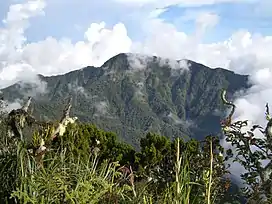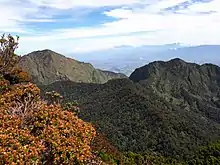| Mount Dulang-dulang | |
|---|---|
| |
 Mount Dulang-dulang viewed from the peak of Mount Kitanglad | |
| Highest point | |
| Elevation | 2,941 m (9,649 ft)[1][Note 1] |
| Prominence | 2,444 m (8,018 ft)[8] |
| Listing | Ultra |
| Coordinates | 08°06′55″N 124°55′15″E / 8.11528°N 124.92083°E |
| Geography | |
.svg.png.webp) Mount Dulang-dulang .svg.png.webp) Mount Dulang-dulang | |
| Country | Philippines |
| Region | Northern Mindanao |
| Province | Bukidnon |
| Parent range | Kitanglad Mountain Range |
| Climbing | |
| Easiest route | Bol-ogan Trail, Sitio Bol-ogan, Barangay Songco, Lantapan, Bukidnon |
Mount Dulang-dulang, dubbed by Filipino mountaineers as "D2" and also known as Mount Katanglad, is the highest elevation peak in the Kitanglad Mountain Range, located in the north central portion of the province of Bukidnon in the island of Mindanao. It is the second highest mountain of the Philippines at 2,941 metres (9,649 ft) above sea level, second only to Mount Apo of Davao at 2,956 m (9,698 ft) and slightly higher than Mount Pulag of Luzon, the third highest at 2,928 m (9,606 ft).[1]
The mountain is regarded by the Talaandig tribe of Lantapan as a sacred place. It is also within the ancestral domain of the tribe. The mountain range is the ancestral home of the Bukidnon, Higaonon, and Talaandig indigenous peoples.[10]
Geography

Mount Dulang-dulang, similar to other peaks located in the Kitanglad Mountain Range, is covered by lofty forests and is a home to a variety of fauna and flora. It is home to 58 mammal species, including bats, squirrels, monkeys, wild boars, flying lemurs, shrews, and deer.[1]
The Philippine eagle is also sighted within the vicinity of the mountain.[11] At least 58 families and 185 species of trees and other woody vegetation species are found within Mount Kitanglad Range Natural Park.[12]
Hydrological features
Mount Dulang-dulang, including the Kitanglad Mountain Range, is the headwater catchment area of several major river systems which include the Maagnao River and Alanib River, tributaries of the Pulangi River, which drains into the Rio Grande de Mindanao in Cotabato City.
The Sawaga River main is main water of the Bukidnon people for homes and agriculture.[10]
See also
Notes
- ↑ Several sources state elevation, prominence and country rank information of another peak matching the data of Mount Dulang-dulang. These sources list a mountain named "Mount Katanglad" (spelled with "Ka" instead of the "Ki" in the usual spelling of Mount Kitanglad) with an elevation of 2,941 m[2] and a prominence of 2,440 m.[3][4] Several other sources evaluated as very reliable for this information give the elevation of Mount Kitanglad (with an "i") as 2,899 m.[5][6][7] Information gathered from these sources suggests that the elevation and prominence information of Peaklist and Peakbagger is in error for Mount Katanglad (with an "a"), and likely refer to nearby Dulang-dulang. Since the discovery of this error, Peakbagger (a site previously in error over the confusion between the two peaks) now has a verified page for "Mount Dulang-dulang",[8] confirming the above information for the peak. Additionally, Peakbagger now also has a page for "Mt. Kitanglad" (with the correct spelling with an "i" and the corrected elevation data)[9] explaining the mistake, though the Kitanglad page does contain a disclaimer stating its information is currently unverified.
References
- 1 2 3 "Mount Dulang-dulang". Pinoy Mountaineer. Archived from the original on January 14, 2014. Retrieved December 19, 2010.
- ↑ "Mount Katanglad". peakery.com. Archived from the original on November 23, 2011. Retrieved March 13, 2012.
- ↑ "Mount Katanglad, Philippines". Peakbagger.com. Retrieved March 13, 2012.
- ↑ "PHILIPPINES MOUNTAINS : 29 Mountain Summits with Prominence of 1,500 meters or greater". peaklist.org. Retrieved March 13, 2012.
- ↑ "Mt. Kitanglad (2,899+)" PinoyMountaineer.com. Retrieved March 11, 2012.
- ↑ A. Townsend Peterson; Thomas Brooks; Anita Gamauf; Juan Carlos T. Gonzalez; Neil Aldrin D. Mallari; Guy Dutson; Sarah E. Bush; Dale H. Clayton & Renato Fernandez (2008). "The Avifauna of Mt. Kitanglad, Bukidnon Province, Mindanao, Philippines" (PDF). Fieldiana Zoology. Field Museum of Natural History (114): 1–43 [2]. Archived from the original (PDF) on September 2, 2009. Retrieved March 13, 2012.
- ↑ Agnes C. Rola, Antonio T. Sumbalan & Vellorimo J. Suminguit (2004). Realities of the Watershed Management Approach: The Manupali Watershed Experience (PDF). Discussion Paper Series No. 2004-23. Philippine Institute for Development Studies. p. 4 (note 6).
- 1 2 "Mount Dulang-dulang, Philippines" Peakagger.com. Retrieved April 25, 2014.
- ↑ "Mount Kitanglad". Peakbagger.com. Retrieved December 29, 2015.
- 1 2 Balane, Walter I. (May 18, 2012). "Lumads decry Mt. Kitanglad bombing, demand ritual to appease spirits". MindaNews. Retrieved July 3, 2020.
- ↑ Lasco, Gideon. "Beyond Apo: Seven great hiking destinations in Mindanao". ABS-CBN News. Retrieved July 3, 2020.
- ↑ Canoy, Ma. Easterluna Luz S.; Suminguit, Vellorimo J. (2001). "The Indigenous Peoples of Mt. Kitanglad Range Natural Park" (PDF). Social Watch. Retrieved July 3, 2020.